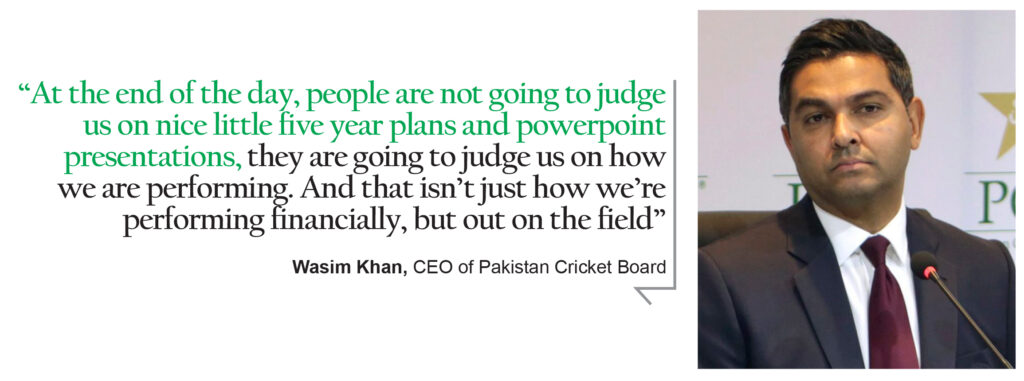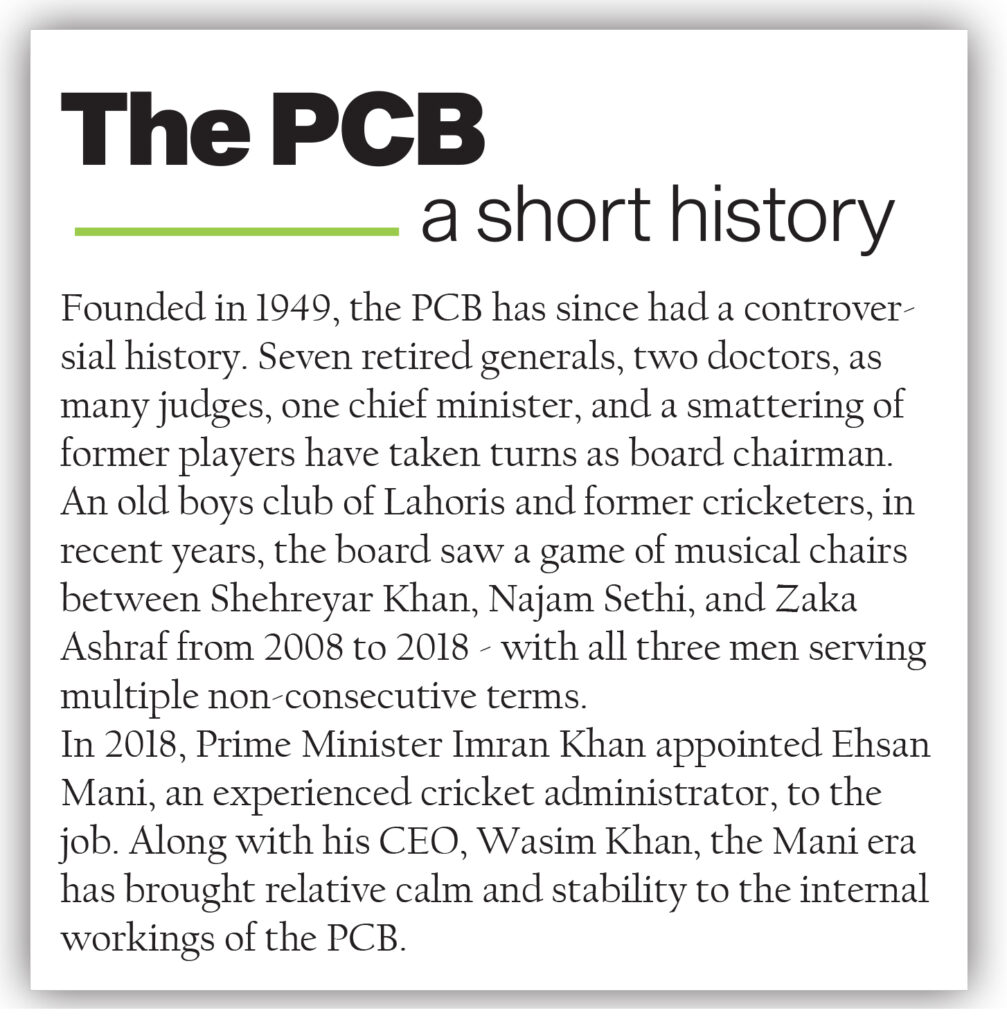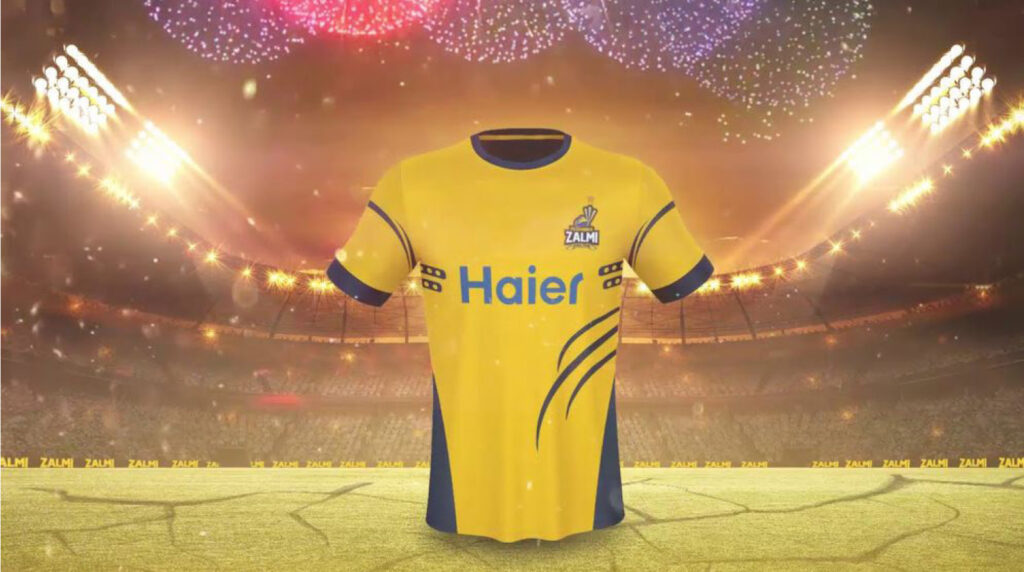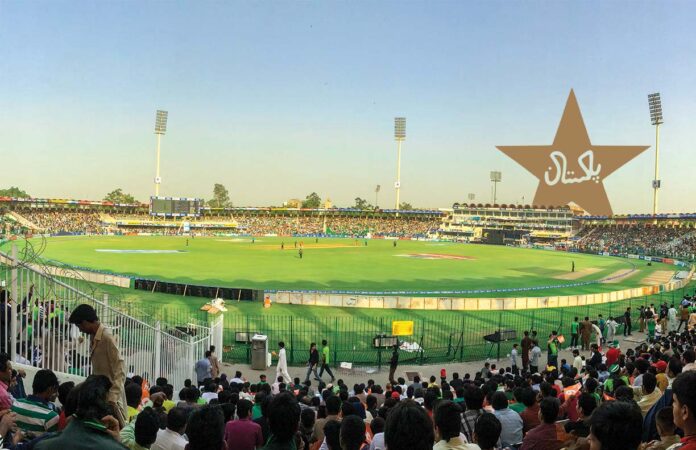Mention the Pakistan Cricket Board (PCB) to a cricket fan and you are likely to get a snarl, a glare, and either a string of profanities unfit to publish, or if you are lucky, a brusque request to change the topic. If you ask someone that does not follow cricket, you will most like receive a shrug and a non-committal comment about hearing that the board is inefficient.
What you will not get, is an understanding of what exactly it is that the PCB does. Most people that pay attention to the cricket board are cricket fans, and the only reason they care is that the board is responsible for selecting teams, naming captains, choosing coaches, organizing tours, and making the case for Pakistan cricket internationally. The part that usually gets overlooked is that the PCB is supposed to run and make money like a corporation.
The idea is that the PCB should make money so that they can then invest back into the game of cricket. So if in any given year the board makes a big profit, they then have more spending power to invest in facilities, salaries, foreign coaching staff, marketing and most importantly – the players.
For years, however, the PCB has been an organization that has been symbolic of everything wrong with Pakistan – stubborn, rooted in all the wrong traditions, prone to political favouritism, sluggish, and in desperate need of reform and modernization.
Those reforms may be on the cards, and with it, a new era for the PCB. One where they are pushing hard to change their image and their ways to become not just any old cricket board looking out for former players and handing out jobs, but one that is a lean, mean, business, machine.
The architect behind this revamp is Wasim Khan, the British-Pakistani ex-county cricketer with an MBA from Warwick University who has been the CEO of the PCB since February 2019. Under his leadership, the PCB has done well. After years of being either stagnant or in loss, the PCB declared an after tax profit of Rs 3.8 billion. The cricket board’s reserves now stand at Rs.17.08 billion compared to PKR13.28billion in the 2018-19 financial year. Other than the net profit, the board has also seen an increase in income of 108pc, bringing in Rs 10.696 billion through different sources this year compared to the year before.
But for the PCB’s critics, the numbers are not particularly impressive, because for them the only game changer has been the Pakistan Super League (PSL), which was the brainchild of the Najam Sethi era, and has since become a cash cow for Pakistan cricket. Profit looks into the business end of cricket in Pakistan.
Where’s all this money coming from?
There are two main sources of income for a cricket board. The first is the International Cricket Council (ICC). The ICC hosts international tournaments like the Cricket World Cup and the T20 World Cup or the Champions Trophy, which attract cricket fans from around the world. From these tournaments, through gate receipts, broadcasting rights, and sponsorship deals, the ICC makes billions. In the projections for ICC’s 2015-23 cycle, the council is supposed to make up to $3 billion, which is then distributed through the different cricket boards. Larger boards that bring in larger television audiences like India and Australia get larger shares. Currently, the ICC is giving around $16.5 million to Pakistan annually until 2023.

For this money, the PCB is completely dependent on the ICC. The main and most traditional way for a board to make its own money is by hosting bilateral series. For example, the Pakistan Cricket Team is currently in New Zealand, where they are due to play a full tour. Now, since the tour is being hosted by New Zealand, Pakistan makes no money from the broadcasting rights, and all of that goes to the host country. In a pre-Covid world, gate receipts would also be a moneymaker for the board hosting.
Pakistan will make money from broadcasting rights when it hosts tournaments, like the recent series with Zimbabwe or the PSL’s latest edition. “In essence, what has happened with the PCB is that it has normally relied on two sources of income – broadcasting deals, and ICC handouts,” says their CEO, Wasim Khan. “Each board receives 20-30% of annual revenue through the handout.”
“The ICC gives $16.5 million annually to the PCB in handouts, and they earn $27 million annually from home tours, the bulk of which comes from broadcasting rights,” says Dr Nauman Niaz, Director Sports & Syndication of the PTV, and legendary cricket show host. The ICC handouts are vital for any cricket board, but they mean that the boards are tethered to the ICC. To have some semblance of independence, it is important for boards to up their broadcasting game.
Pakistan cricket has been lagging behind in this department. Broadcasting quality and techniques have not been up to the mark since the turn of the century. No deals had been signed with international broadcasters to take Pakistan’s home matches to a larger audience and attract more money, and the deals signed with broadcasters at home were less than ideal. This is one particular area where the PCB has made strides in becoming self-sustainable. They have made overtures to improve broadcasting, have developed a robust and creative media team and are in constant talks to further sign broadcasting deals.
“We have recently signed a $200 million deal with the PTV. Currently, we are producing content through third parties and providing our content to PTV for broadcasting, but this is only in the short-term, we are in this for the long-haul,” says Wasim Khan.
For the British educated, soft-spoken, and very un-PCB like CEO, the key word is sustainability. He wants to change the PCB from the ground-up, but does not want to leave the board rudderless. “Within the next few years, we want to be in a position where we are producing ourselves and do not need third parties. Our capabilities have lacked, so we are training the PCB staff so that we can rid ourselves of third parties,” he says. “We need to contain a sustainable system that requires training. We want the money to stay within Pakistan.”
Other than PTV, the PCB has also signed a deal with Super Sport – a South African broadcaster that has agreed to show Pakistan’s matches on its networks. According to Wasim Khan, the board is on the verge of making similar deals with other international broadcasters as well, including Sky Sports in England as well as the California based Fox Sports.
But these are the traditional sources of income for the PCB. As long as the board is dependent on ICC handouts, the PCB will never be an independent board and always a wrong move away from falling in disfavour and not getting as much money. Particularly, with the Board of Control for Cricket in India (BCCI), not only dominating the ICC, but allying with the Australian and English cricket boards to create a triopoly in cricket has resulted in a greater than ever need to diversify sources of income and become independent from the ICC.
The continued problems
Here’s the rub. No matter how many broadcast deals the PCB signs, as it has with PTV for the 2020-23 period and with Super Sports now, the value of this deal will be diminished as long as India continues to not play Pakistan in bilateral series. With a population of over a billion people, the Indian television audience is huge, and can make or break the income of cricket boards, all of whom are keen to have India tour them so that their vast population tunes in to watch their team play.

The only time Pakistan now plays India is in ICC tournaments, the last bilateral series having come in 2012, and that too had been hosted by India. The last time Pakistan hosted India was in 2006. India, on the other hand, has made use of its gigantic television audience and has invested more money into its cricket than any other board in the world, and in turn finding and developing some of the best players the game has ever seen.
Pakistan, on the other hand, has been teetering because of a lack of funds. While Pakistan still got the broadcasting money from their ‘home tours’ that they hosted in the UAE after the attack on the Sri Lankan cricket team in 2009, not hosting cricket at home has been a big blow, since there are a lot of economic wheels that turn because of cricket.
“There is an entire ecosystem that cricket has around it. When you have matches at home, that stimulates the entire economy,” says Wasim Khan. “There are 20 million people in Pakistan, and most of them are passionate cricket fans. They come to watch the games, hotels are booked, there is transportation, security, merchandise, clothing, equipment – cricket is at the center and has a gravitational pull that keeps all these businesses in orbit.”
This is why foreign teams coming to Pakistan have been so important, and the encouragement of the ICC as well as the insistence of the PCB that Pakistan is safe for cricket is to thank. To their credit, the board has stuck to their guns. Recently, when the Bangladesh Cricket Board was teetering on whether or not to come to Pakistan or not, the PCB Chairman Ehsan Mani had categorically snubbed any other possibility by declaring that all of Pakistan’s home matches would take place in Pakistan.
And the great winner here has been the PSL. With the PSL, the board makes money not just through the broadcast, but also through the fees that franchise owners pay them. The PSL has become worth around $300 million to the PCB, and could possibly account for nearly the entire profit that they have made in the last year.
“The PCB gets most of its money from the ICC handouts and from tours. The rest of it comes from PSL franchise fees, PSL ground branding, media rights within the territory, and global digital content exploitation both globally and in Pakistan,” says Dr Nauman Niaz. According to him, there is no corporate revolution within the PCB.
“There is nothing corporate about the PCB, there is nothing new. The only difference is that the PSL has now become a game changer and is the hallmark of the PCB,” says the veteran cricket anchor. “Even the PSL they are damaging, and all of the damage is self-inflicted, and there is no transparency about the income and expenditure disparity.”
Has the PCB changed?
Wasim Khan is cognisant of the critics, and he does not shy away from them. “In any organization, you don’t defeat a 40 year old culture overnight. My job is to identify the quick winds, and what is going to take longer to establish,” he says. “That’s what leadership is about. Finding the balance between mentoring and monitoring.”
“The PCB has had a bad reputation. It was supposed to be an archaic institution geared towards the old ‘jobs for the boys’ mentality. That’s what we are trying to change,” he says. “People did not trust the PCB, and that made our job more difficult, and that is where we wanted to make a change.”
“We decided that with media broadcasting going down, we needed to pay a bigger focus on commercial revenue. We have assessed and evaluated all of our assets, which is the first time in the history of the board, and have also gone into the marketplace to sell. We are also about to announce a decent deal with a global brand. Lined up four sponsors for our cricket associations.” This is where commercial sources come in. As mentioned before, the Pakistan team is currently in New Zealand. While the Pakistan team does not make any money from the broadcast, they do make money from advertising.
The Pakistan team is currently sponsored by Pepsi and Easypaisa, and both those brands are on the team shirts. Pepsi and Easypaisa obviously pay money for this, and that is one of the major revenue streams for the board. While this is an old way of making money (sponsors on cricket shirts have been around for decades), it is one slowly gaining more importance in cricket and in Pakistan. And with events like the PSL, there is more opportunity for this kind of branding and revenue from it.

Dr Nauman Niaz, again, feels that the example of the deal with Pepsi is one that proves the PCB is still the same organization it was five years ago. “They have underachieving commercial deals, and even though it is a place with huge potential, they almost lost their logo deal.”
What he is talking about is the fact that Pakistan could not renew its sponsorship with Gatorade and was having a hard time finding a sponsor to replace them. Eventually, when Pepsi and Easypaisa came on board, the deal was thought to be worth around Rs 200 million. This was a significant fall, since the PCB’s previous deal with Gatorade and other sport brands had been worth Rs 1850 million, and the PCB had been hoping to get a deal at Rs 1 billion. However, in all fairness, the difficulty in finding sponsors was because of the coronavirus, and the PCB did manage to find Pepsi in any case. Especially since, for a brief period of time, it looked like Pakistan would play without any sponsor on its shirt – a possible embarrassment in the cricketing world.
This is the hallmark of the new PCB – sustainability. The focus for Wasim Khan is about derisking the business and becoming less reliant on the ICC and broadcasting. So if the ICC is unhappy with Pakistan or if something like the coronavirus happens and broadcasting revenue is affected, the most important thing to do is find streams of revenue independent from these traditional sources.
“And I think our approach is working. Our reserves have gone up, we have delivered a net profit in both years, after a loss. We are in line with our 5 year plan. We have been delivering against that, which means a lot of streamlining, and that means we’ve spent about a billion rupees less – so our focus is quality rather than quantity.”
Overall, the culture at the PCB has changed. A huge amount of work has gone into developing trust with the PCB, and the board’s media team has gone above and beyond the call of duty to rehabilitate the board’s tarnished image. This was a long time coming, at least since 2010 when the spot fixing scandal had erupted onto the world of cricket. It is now more of an enabling culture, where in the past there were a lot of blockages. This is also visible in how Pakistan is playing cricket and grappling with cricket.
The five year plan that Wasim has brought in and speaks of is symbolic of the kind of change he is trying to catalyze in the PCB. It is glossy, it is modern, it is idealistic and it is frugal. But has it made things better for cricket and the people that play it?.
Are the players, and cricket, any better off?
Since we have been talking so much about profits and the PCB acting like a corporation, let us clarify and reiterate again – the PCB is not a corporation. It does not pay dividends. It does not give out massive bonuses to its executives. Everything they earn is funneled back into Pakistan cricket.
“At the end of the day, people are not going to judge us on nice little five year plans and powerpoint presentations, they are going to judge us on how we are performing. And that isn’t just how we’re performing financially, but out on the field.”
And that is the crux of the issue. We want the PCB to operate like an efficient business because that is how they will make the most money, and then spend that money on cricket and cricketers. Under Wasim Khan, the diktat has been quality over quantity.

A structural note here. Cricket is played in three different formats: tests, 50 overs, and 20 overs. Locally, players have to work their way up from club cricket to ‘first class’ cricket – which is the highest level of local competition from which players are picked for the international game. Most players do not go beyond first class cricket, and even if they do, do not play enough international cricket to make a comfortable living. Therefore it is vital for first class cricketers in any country to have a stable income if they are to focus on their game instead of doing odd jobs on the side.
As sports has become more competitive internationally, even formerly lazy games like cricket require athletic commitment and professionalism. Until a few years ago, first class cricket was contested amongst departments backed by banks, airlines, railways and other organisations. These departments gave stable employment to players, pensions, salaries, and even offered post retirement careers.
As part of their streamlining under the five year plan, the PCB has done away with the dozens of departments and trimmed down first class competition to six regions that include Central Punjab, South Punjab, Northern, KP, Balochistan and Sindh. These six regions select players and battle it out amongst themselves in domestic tournaments in all three formats of the game. With the money this streamlining has saved, the PCB can spend more on coaches, facilities, better pitches, better cricket balls and promoting a better standard of competition. Because of this, domestic cricket in Pakistan has become much more competitive. However, has it been good for the players?
Now, it is important to remember that all players do not play all three formats and neither do they play every single game even if they do. According to an ESPNCricinfo report, under the new regional structure, all first-class cricketers will be paid a monthly retainer of Rs50,000. Additionally, they will receive match fees of Rs75,000 for Quaid-e-Azam Trophy (the PCB’s domestic ‘test’ tournament) games, Rs 40,000 for Pakistan Cup (50-over) games, and Rs30,000 for National T20 games. They will also be paid a daily rate while playing of Rs 2500.
So, over the course of a year, if a player plays all ten QeA trophy group matches (which go four days), five Pakistan Cup games and five T20 games (assuming both are single league formats), he will earn approximately Rs 1.8 million. Potentially, with various forms of prize money, that could go up to Rs 2 million. That, however, is only if he is an all-format pick and plays as many games as that. So if you are good enough to play every domestic game possible, then you are likely to make Rs 2 million a year (Rs 166,666 a month) – and there are credible reports that the PCB have paid that amount, possibly more, for just the design of the new QeA logos.
The goal, at the end of the day, is to win on the field. And more competitive cricket is necessary for that. But should that be coming at the cost of the livelihood of players? For Wasim Khan, there have been some very particular changes, and key among them have been making the board a leaner, more efficient organization. “In the last year, the PCB has spent a billion rupees less than they did the year before by decreasing the teams and focusing on regional cricket,” he says.
Cricket is important for Pakistan. As a sport and an institution, it is sluggish, it is stubborn, it is long even in its shortest form and a relic of colonialism. But in the countries in which the British left cricket as an inheritance, the game has the capacity to build nations and moments of our collective memory. India has come to define itself by cricket. Pakistan and Sri Lanka have had some of their most significant national moments by winning the cricket World Cup in 1992 and 1996 respectively. Bangladesh has continued to establish its independence through cricket. For decades, the West Indies fought revolutions through cricket, with figures like Sir Vivian Richards becoming awesome figures in the public imagination.
Any sport is an exercise of the soul. There is something vital, something essential, something very strongly human about sports and the stories they tell, and for Pakistan, the sport we have chosen for our story is cricket. But what is cricket if not the people that play it? First class cricketers must get a better deal than the one they have right now.
In defence of the PCB
Once again, it is important to remind our readers of the fundamental changes that are taking place in the PCB. It is a more driven organization with intent and a desire to make cricket in the country better. We have talked about domestic cricketers getting the short end of the streamlining stick, but the PCB is well intentioned.
For starters, Pakistan is the only country in the world to hold a full domestic season despite the coronavirus pandemic, keeping cricketers both active and giving them opportunities to earn money. The final leg of the postponed PSL has been completed, with Karachi Kings winning the tournament, Zimbabwe toured Pakistan, and after going to England, Pakistan are currently in New Zealand for a tour.
Domestic cricket will not make money for Pakistan cricket, in fact, it is very expensive, and because of Covid protocols, it is even more expensive than usual, something Wasim Khan readily accepts. “The financial statements for the current year are not looking as good as they have for the past couple of years, but that is because of our Covid procedures,” he says. “We are hosting the domestic players in four star hotels, we have conducted more than 2000 tests, why are we doing this? Because first class cricket is the pipeline for international cricket, and if we spend on our players here, we will have a good pool of players.”
“I do not consider this an expenditure. It is an investment because these players are our future.” And even though Dr Nauman Niaz says that the culture at the PCB has not changed, or has at the very least not been changing fast enough, results have become apparent. And while none of it is perfect, Wasim Khan and the PCB are more than happy to chip away at the old image and culture of the PCB. And as long as their efforts remain vigilant and sincere, Pakistan cricket will owe them a debt in the years to come.


























Wasim Khan has been a blessing for Pakistan Team. More power to you. Keep it up!!!